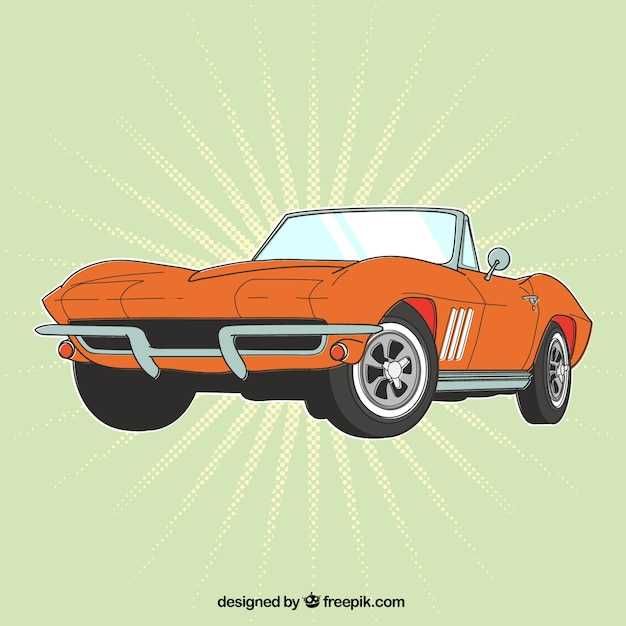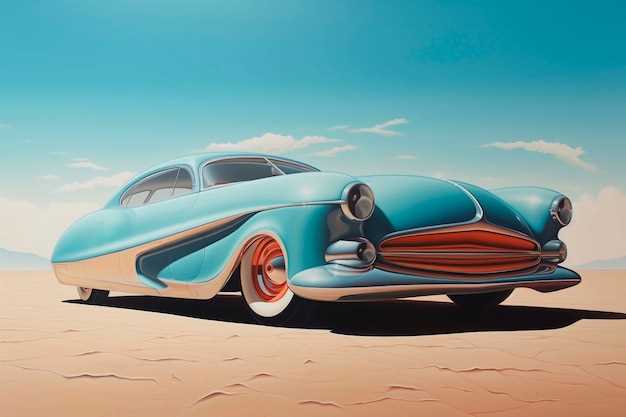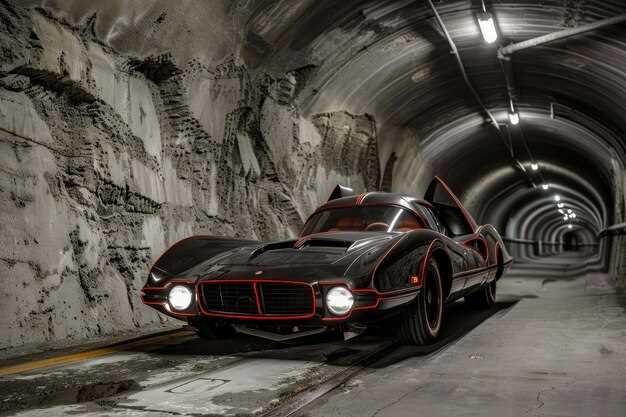
The Corvette Stingray has long been a symbol of American automotive excellence, captivating enthusiasts and collectors alike since its inception. This legendary sports car, produced by Chevrolet, has undergone significant transformations over the decades, reflecting the advancements in engineering, design, and performance. Each generation of the Stingray tells a unique story, rooted in innovation and a relentless pursuit of speed.
From its debut in 1963, the original Corvette Stingray was designed to be more than just a car; it was a statement of American automotive prowess. Its distinctive lines and powerful engine set the stage for a legacy that would continue to evolve. As we trace the history of the Stingray models, we uncover the technological breakthroughs and design choices that have defined this iconic vehicle and cemented its place in automotive history.
As we delve into each generation, we will examine the factors that influenced the Corvette Stingray’s design philosophy, the competition it faced, and how it adapted to the changing automotive landscape. The Stingray is not merely a car; it is a testament to American ingenuity, a canvas for creativity, and a symbol of freedom on the open road.
Evolution of the Corvette Stingray Design
The Corvette Stingray design has undergone a remarkable transformation since its inception, reflecting both technological advancements and changing aesthetic preferences. The first-generation Corvette, introduced in 1953, featured a streamlined body with an elegant appearance. This initial model laid the groundwork for what would become an iconic sports car.
In 1963, the Stingray name was officially adopted with the arrival of the C2 generation. This model showcased a more aggressive and aerodynamic design, highlighted by its distinctive split rear window. The C2’s sculpted lines and sleek profile established a new standard for performance vehicles, emphasizing both speed and style.
The third generation, initiated by the C3 in 1968, introduced a more pronounced and curvier design language. Inspired by the Mako Shark concept, the C3 featured long, flowing lines and wide fenders, enhancing its presence on the road. This generation retained the Stingray moniker, solidifying its legacy in automotive history.
The 1984 C4 generation marked a significant departure with a focus on modernity and refinement. The design shifted towards sharper angles and boxier shapes, reflecting the technological influences of the era. The C4 allowed for improved aerodynamics and performance, embracing a new approach to Corvette styling.
With the arrival of the C5 in 1997, the Corvette Stingray experienced a renaissance. The design incorporated a more rounded aesthetic while improving overall performance metrics. The sleek body contours and enhanced aerodynamics helped to redefine the Corvette’s identity in the 21st century.
The C7 generation, launched in 2014, showcased a bold and aggressive stance, combining luxury and performance. Its sharp lines, wide body, and signature LED lighting created a striking modern appearance, appealing to both enthusiasts and casual drivers alike. This design philosophy continued to emphasize the Stingray’s racing heritage while integrating contemporary features.
Finally, the latest iteration, the C8, unveiled in 2019, represents a groundbreaking shift with its mid-engine layout. This design not only enhances performance capabilities but also transforms the aesthetic into a masterpiece of engineering. The aggressive yet refined exterior, combined with innovative interior design, positions the Corvette Stingray as a leader in the sports car market.
Overall, the evolution of the Corvette Stingray design embodies a continuous journey of innovation, performance, and aesthetic excellence. Each generation builds upon the last, ensuring the Corvette remains an enduring symbol of American automotive achievement.
Performance Innovations Over the Generations
The Corvette Stingray has long been synonymous with performance, showcasing a remarkable evolution in engineering and technology over its various generations. Each iteration has introduced innovative enhancements that not only improve speed and handling but also enhance the overall driving experience.
In the original C1 generation introduced in 1953, the Corvette established its reputation with a lightweight fiberglass body and a small-block V8 engine. This combination provided a robust foundation for future models. The C2, released in 1963, further advanced the performance spectrum with the introduction of the Sting Ray moniker, offering improved aerodynamics and the first independent rear suspension on a Corvette, significantly enhancing handling dynamics.
With the arrival of the C3 in 1968, performance innovations included a wider stance and powerful engine options, such as the legendary LS6 454 cubic inch V8, enabling exhilarating acceleration and top speeds that set benchmarks for muscle cars of the era.
The introduction of the C4 in 1984 marked a pivotal shift towards modern performance engineering, featuring a comprehensively redesigned chassis and advanced technology. Innovations such as digital instrumentation and the use of a lower center of gravity provided improved stability and agility.
As the generations progressed, the C5 (1997) was the first to offer a transaxle design, which balanced weight distribution and improved handling. This model also introduced a LS1 engine, combining light weight with substantial power, making it one of the most effective Corvettes ever produced.
The C6 (2005) continued this trend with enhancements such as increased chassis rigidity and the introduction of the ZR1 variant, which featured a supercharged LS9 engine, pushing the performance envelope with a remarkable 638 horsepower.
Finally, the C7, launched in 2014, showcased cutting-edge technology with its lightweight aluminum structure, advanced aerodynamics, and the introduction of magnetic ride control, allowing for real-time adjustments to suspension settings for optimum performance. The Z06 variant further solidified its status with an LT4 engine producing 650 horsepower.
The latest C8 generation represents a radical departure with its mid-engine layout, providing improved weight distribution and enhancing acceleration and cornering capabilities. The introduction of a dual-clutch transmission enhances responsiveness, representing the pinnacle of Corvette performance innovations.
| Generation | Key Performance Innovations |
|---|---|
| C1 (1953-1962) | Fiberglass body, small-block V8 engine |
| C2 (1963-1967) | Independent rear suspension, enhanced aerodynamics |
| C3 (1968-1982) | Wider stance, LS6 V8 engine |
| C4 (1984-1996) | Modern chassis design, digital instrumentation |
| C5 (1997-2004) | Transaxle design, LS1 engine |
| C6 (2005-2013) | ZR1 variant, LS9 supercharged engine |
| C7 (2014-2019) | Magnetic ride control, performance-oriented design |
| C8 (2020-present) | Mid-engine layout, dual-clutch transmission |
Through the decades, the Corvette Stingray has continually redefined performance, blending innovation with tradition, and ensuring its place as an automotive icon in high-performance sports cars.
Significant Milestones in Stingray Production

The Corvette Stingray has a storied history marked by several significant milestones that have defined its evolution and impact on the automotive world.
One of the earliest milestones occurred in 1963, with the introduction of the first-generation Stingray (C2) model. This iconic vehicle featured a distinctive design characterized by its split rear window and sculpted body lines, setting a new standard for sports cars in America.
In 1967, the Stingray lineup reached new heights with the release of the C2’s final iteration. This model introduced the powerful 427 cubic inch V8 engine, which solidified the Corvette’s reputation for performance and speed, appealing to enthusiasts and collectors alike.
The launch of the third-generation Corvette Stingray (C3) in 1968 marked another pivotal moment. This model showcased a more aggressive design and a range of advanced features, including T-tops, which allowed for a unique open-air driving experience. The C3 Stingray became a symbol of American muscle during its production run until 1982.
Fast forward to 2014, and the introduction of the C7 Corvette Stingray brought modern technology to the forefront. This model featured a lighter chassis, improved aerodynamics, and a new naturally aspirated 6.2-liter V8 engine. The C7 was praised for its performance capabilities, making it one of the best-performing models in the Corvette lineup.
In 2020, the Corvette Stingray underwent a revolutionary transformation with the debut of the C8. It shifted to a mid-engine layout, enhancing handling and balance, while continuing to deliver world-class performance. This model represents a significant shift in the Corvette’s identity and redefines the expectations for American sports cars.
Each of these milestones reflects the innovative spirit and continuous improvement that defines the Corvette Stingray, ensuring its place in automotive history as a leader in performance and style.
Comparison of Classic and Modern Stingray Features

The Corvette Stingray has a rich heritage, showcasing the evolution of automotive engineering over the decades. Classic Stingray models, such as the C2 introduced in the 1960s, emphasized a sleek, aerodynamic design coupled with a powerful V8 engine. These vehicles are renowned for their distinct looks, featuring sharp lines and rounded rear ends. The emphasis on raw power and simplicity is evident in the driving experience, characterized by a manual transmission, lightweight construction, and a focus on driver engagement.
In contrast, modern Stingray models, like the C8, represent a significant shift in design and technology. The introduction of a mid-engine layout allows for improved weight distribution, handling, and performance. Advanced materials such as carbon fiber and aluminum are utilized to enhance structural integrity while reducing weight. Modern Corvettes are equipped with cutting-edge technology, including advanced digital dashboards, adaptive cruise control, and a range of connectivity features that were unimaginable in the classic era.
Performance metrics have also evolved dramatically; while the classic models offered exhilarating power, modern Stingrays boast enhanced horsepower and torque through advanced engine technologies and performance tuning. The driving dynamics are complemented by sophisticated suspension systems designed to provide both comfort and precision on the road. Furthermore, safety features, which were minimal in classic models, are now a significant focus, with modern Corvettes incorporating advanced collision avoidance systems and traction control.
Despite these differences, both classic and modern Stingrays share the passion for performance and the spirit of American muscle. The nostalgia associated with classic models appeals to enthusiasts who value the traditional elements of the Corvette lineage, while modern iterations attract those seeking innovation and state-of-the-art performance. Together, they reflect the ongoing legacy of the Corvette Stingray as an icon of automotive excellence.
Impact of Stingray on American Sports Car Culture
The Stingray, particularly in its various iterations since its debut in 1963, has left an indelible mark on the landscape of American sports car culture. As a symbol of performance and style, the Stingray has captivated car enthusiasts and the general public alike, setting a standard for what a sports car should embody.
First introduced with a sleek design that combined aerodynamics and aesthetics, the Stingray represented a bold departure from its predecessors. Its introduction to the market coincided with the rise of a youth-driven automotive culture in the 1960s, when American consumers sought not just transportation but an expression of freedom and individuality. The Stingray quickly became synonymous with the American muscle car movement, showcasing powerful engines and exceptional handling capabilities.
The Stingray’s influence extended beyond its performance specifications. It became a staple in popular culture through film, music, and racing. Iconic movies featuring the Stingray solidified its status as a cultural icon, inspiring generations and cementing its place in the hearts of car enthusiasts. Its presence in competitive motorsports further demonstrated the model’s capabilities, proving that performance and style could coexist in a single vehicle.
As generations of Stingrays evolved, they continued to push boundaries in technology and design, influencing not only competitors but also setting industry standards. The Corvette Stingray’s evolution reflects changing consumer preferences and advancements in automotive technology, showcasing the model’s adaptability and relevance in the ever-evolving sports car market.
In conclusion, the Stingray has profoundly shaped American sports car culture, establishing a legacy that combines performance, design, and a strong connection to the American spirit. Its impact is not just measured in sales figures, but in the fervent passion it has ignited within car communities and its enduring status as a symbol of American engineering prowess.
Future Prospects for the Corvette Stingray Lineage
The Corvette Stingray lineage has long been synonymous with innovation, performance, and cutting-edge automotive design. As we look to the future, several key trends and developments are likely to shape the evolution of this iconic model.
- Electrification: The automotive industry is increasingly moving towards electric vehicles (EVs). The Corvette Stingray may adopt hybrid or fully electric powertrains to reduce emissions while enhancing performance. This shift could result in new models that maintain the speed and agility synonymous with the Stingray name.
- Advanced Technology: The integration of advanced technologies, including autonomous driving capabilities and enhanced connectivity, is expected to play a crucial role. Future Stingray models may feature cutting-edge driver-assistance systems that could provide a balance between luxury and sportiness.
- Performance Enhancements: The hallmark of any Stingray is its performance. Future iterations are likely to focus on refining aerodynamics, weight distribution, and chassis dynamics, potentially utilizing lightweight materials to improve speed and handling.
- Sleek Design Evolution: While maintaining the classic aesthetics, future Stingray designs may embrace bolder, more aggressive styling cues. This could appeal to a new generation of enthusiasts while honoring the rich heritage of the model.
- Customization Options: The demand for personalized vehicles continues to rise. Future Stingrays may offer a wider range of customization options, allowing owners to tailor their cars to their unique preferences, from performance tweaks to aesthetic enhancements.
As we move forward, the Corvette Stingray is poised to adapt and thrive in a rapidly changing automotive landscape. By keeping pace with technological advancements and consumer demands, the Stingray will ensure its legacy continues to resonate with driving enthusiasts worldwide.




